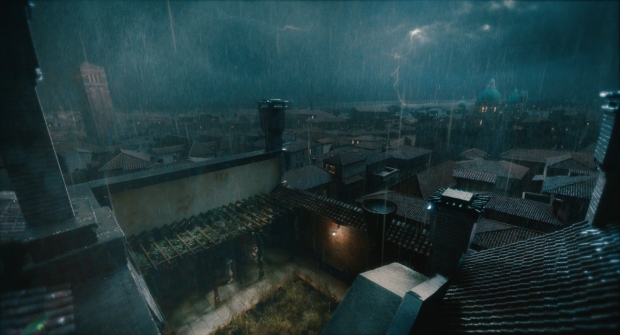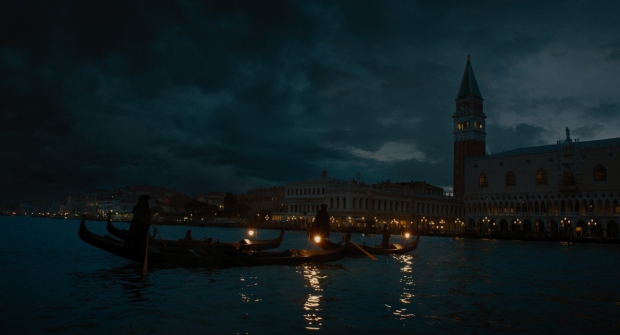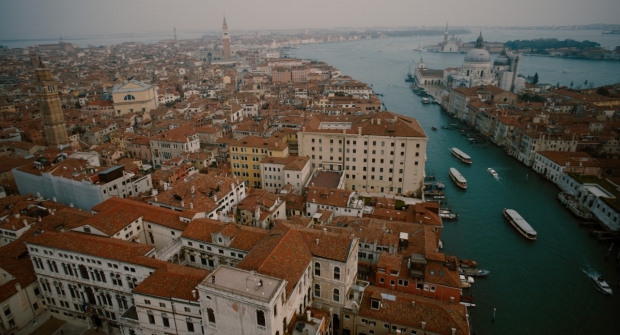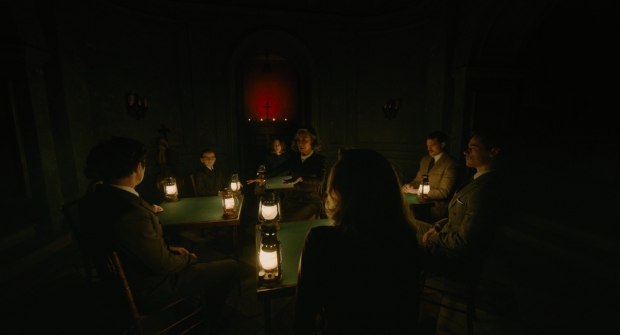Production VFX Supervisor Artemis Oikonomopoulou talks ghosts, cryptic water messages, and 1947 Venice, along with lots of invisible effects – and some CG bees – on the director’s third outing as famed Belgian detective Hercule Poirot in the latest cinematic adaptation of an Agatha Christie novel.
Typically, haunted stories deal with a lot of spooks and an equal measure of spectacle. But when Cinesite was brought on to do VFX for A Haunting In Venice, director Kenneth Branagh noted he wanted effects that kept audiences guessing as to what was real, and what wasn’t.
A Haunting In Venice, now playing in theaters, is loosely based on the 1969 Agatha Christie novel “Hallowe'en Party.” With a screenplay by Michael Green, the film serves as a sequel to Death on the Nile (2022) and Murder on the Orient Express (2017) and is the third film in which Branagh reprises his role as the Belgian detective Hercule Poirot.
This latest film takes place in 1947. Poirot lives in retirement in Venice, employing ex–police officer Vitale Portfoglio as a bodyguard. On Halloween, mystery writer Ariadne Oliver (Tina Fey) convinces Poirot to attend a séance at the palazzo of famed opera singer Rowena Drake (Kelly Reilly) and expose Joyce Reynolds (Michelle Yeoh), a World War I army nurse turned medium, as a fraud. Poirot reluctantly attends the séance. But when one of the guests is murdered, it is up to the former detective, once again, to uncover the killer while simultaneously investigating the mysterious “ghosts” that inhabit the palazzo.
Produced by 20th Century Studios, A Haunting In Venice enlists the expertise of Cinesite –known for its effects work on films such as The Witcher, Matilda, Peter Pan & Wendy, and Wheel of Time, among many others. Cinesite, as the main vendor, oversaw a majority of the film’s effects shots, from storms and set extensions to ghosts and cryptic water messages.
Artemis Oikonomopoulou, who previously worked on films like Thor: Love and Thunder, Cyrano, and Death on the Nile, served as the Production VFX Supervisor, overseeing creation of the eerie aesthetics of Branagh’s newest murder mystery. Oikonomopoulou chatted with AWN about how she and her team seamlessly interwove a digitally adjusted Venice and bee-infested skeletons into the real shots of A Haunting In Venice and kept audiences guessing along with Poirot about the authenticity of certain scenes.
Victoria Davis: How did you and your team at Cinesite initially get involved with A Haunting In Venice?
Artemis Oikonomopoulou: We got the script early last summer. 20th Century wanted an effects supervisor from Cinesite and I got started on production that August.
VD: What excited you about this film? I noticed you also worked on Death on the Nile as an on-set digital effects supervisor. Did that play a role?
AO: I love Agatha Christie and I love Poirot. But, of course, Kenneth Branagh, the director, was also a very big pull. I’ve been very interested in his work for many years. So it felt like a great project to be on. And I had just finished working on Thor, which was a very different kind of production. There’s a lot more VFX on that one and it felt really good to do something that was a little bit more based on reality and a little bit less VFX heavy.
VD: More of the VFX that you don't see.
AO: Exactly.
VD: There's certainly a lot of that in this film, but you’ve also got ghosts and storms and such. There are a couple realms of VFX here. What were Cinesite’s main responsibilities?
AO: We did roughly 470 shots in the film series. There was a lot of the cleanup work that you get in period films, because, obviously, there's a lot of modalities that need to be cleaned up for when we're in Venice. But the majority of the work, and the stuff that Cinesite worked on, was doing a lot of rain enhancements and set extensions.
Most of the film takes place inside a palazzo, which we were shooting on stage in Pinewood Studios. But, for the exteriors, we shot some stuff on occasion in Venice. And then we also built a miniature model. All those three areas were meant to be the same palazzo, so we kind of had to stitch all of them together and make them all look like it was actually the same building. With the real palazzo in Venice, we changed the building a little bit and added another floor at the top and the bell tower.
While they're inside, there's a storm brewing with heavier and heavier rain, so we did a lot of exteriors where we added rain or enhance what was there because it was hard for the camera to read the rain that we had shot if it wasn't lit properly. We also added waves on the canals, sky extensions, and did a lot of drone shots outside.
VD: What’s involved for set extensions of wide drone shots. Because you can’t exactly use the bluescreen.
AO: We first took a LiDAR scan of the palazzo when we were in Venice and then used that to extrapolate the camera. And then you cover the backgrounds with lots of matte paintings or new CG buildings, depending on the camera work and if there’s much parallax. And then, obviously, we just add lots of rain, lots of fog, and other effects.
VD: A while back, I got to talk to the VFX team at Cinesite about the newest Peter Pan film, and that work also required a lot of set extensions. Is this kind of work something for which the studio is starting to become known and sought-after?
AO: Cinesite has always done quite a lot of environment work and quite a lot of set extensions. In some cases, it is a little bit of the bread and butter work of VFX. I don't think I've worked on any film that does not have set extensions, even if it's a creature-heavy show.
VD: That said, were there aspects of this production that made it unique or particularly interesting for Cinesite?
AO: You tend to work on one sequence that is like a repeat of 150 shots, but here there were lots of different little things, which I think made it quite interesting. There are moments when the character is hallucinating and is seeing random things that the audience is not supposed to understand whether it's real, whether there's actually ghosts, or if there’s something else going on.
There’s one shot where Poirot looks up and he suddenly sees water coming down, and it sort of spells the letter “M,” like a reference to “murder.” Then there's another shot in the basement of the palazzo where we see a skeleton of a child that has been there a long time and, when the actors go near, it disturbs these bees that have been living in this skeleton, and they come flying out.
VD: Having worked on the rain and the storm VFX, were you also responsible for that scene with the floating ghost off the Palazzo balcony?
AO: The ghost of the girl who dies in the film? Yes. We shot that with the actress on wires on set against a backing of Venice that we ended up replacing. So we did a combination of CG and DMP for the background, cut her out and then put her in and then added lots more rain.
VD: Were there ways you wanted your work to look unique/different from other movies about hauntings and the supernatural, such as when it came to the look of the ghost?
AO: The look of the ghost was very much set in reality. The director never wanted anything to really look ghostly and out of reality. He wanted her to look like she was a person, and then the audience could make up their own mind on whether it was a ghost or not. Really, the only thing that distinguishes her as potentially a ghost is that she’s pale and floating.
VD: One of the other visuals that really captured me in this film was the paper lamp that's going around and around during the seance, and this animation comes to life. Was that an effect as well?
AO: No, that was shot for real, on a real zoetrope. Going back to the early days, it was one of the first ways people tried to do animation.
One of my draws to this film, and one of the main takeaways when I first met the director, was that there was going to be as much real in-camera shooting as possible. The two previous installments of these films had a lot of heavy VFX. And, with this one, Kenneth wanted it to be based on reality as much as possible. Our role was to help when something just couldn't be shot for real and to enhance and just to add production value, rather than build something from scratch.
VD: The VFX wasn’t a first resort.
AO: Exactly. The invisible VFX is actually quite great because most people, hopefully, will watch without really knowing what’s real and not real, which is especially great for this story.
VD: That’s one of the things I enjoy most about writing these stories, getting to pull back the curtain and say, “Hey, look at all the work that was put into making just one landscape shot!” Most people are pretty taken aback by what’s hidden right under their nose with these things.
AO: It is really cool. Everything that was inside the Palazzo was a set and it was so beautiful and amazing, you’d never know.
VD: How much time did you and the team get to spend on set?
AO: Oh, I was there every day, beginning August 1, when we started prep. Then we went to Venice and started shooting on October 31, on Halloween. In January, we were in Venice for a couple of weeks, and then we had a few days outside London to do the miniatures shoot.
An interesting thing is that we had a fairly short post-production time. It was about six months, which is not very much for any film. Normally, it’s eight months at the least.
VD: Of all the VFX you and the team tackled, which of those was probably the biggest challenge?
AO: The shot with the child’s skeleton was definitely a challenge for the sheer volume of work. We had to replace the whole skeleton because the real one wasn’t working out, we added in the pole hitting it from the back and disturbing the bees, as well as the water that is around the floor and the skeleton. It also took a while to get the timing of that shot right, because it's part of a sequence where there is a very particular tempo with the sound and the edit. It was quite a heavy shot.
One that was not necessarily the most difficult but very time-consuming was the final shot of the film where the titles start coming on. It’s an aerial of Venice where we start off on the terrace with Poirot and a secondary character, and then the drone pulls back and starts spiraling around them to reveal Venice and keeps on going higher and higher. That shot was about three minutes long, which is quite a lot in VFX terms. And when you go up that high, there's so much stuff to remove and clean up and fix. There was a lot of construction going on in Venice, modern boats down the canal, and so on. So, tons to fix. And it was the final credits, with everyone’s names. So, we had to make it look good.


























